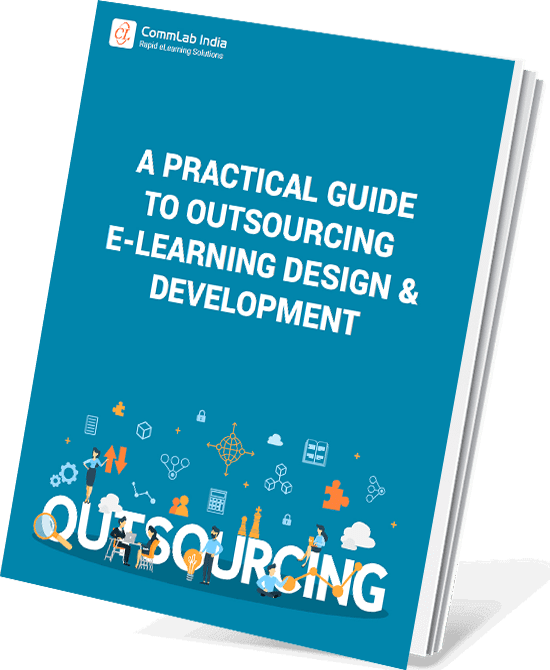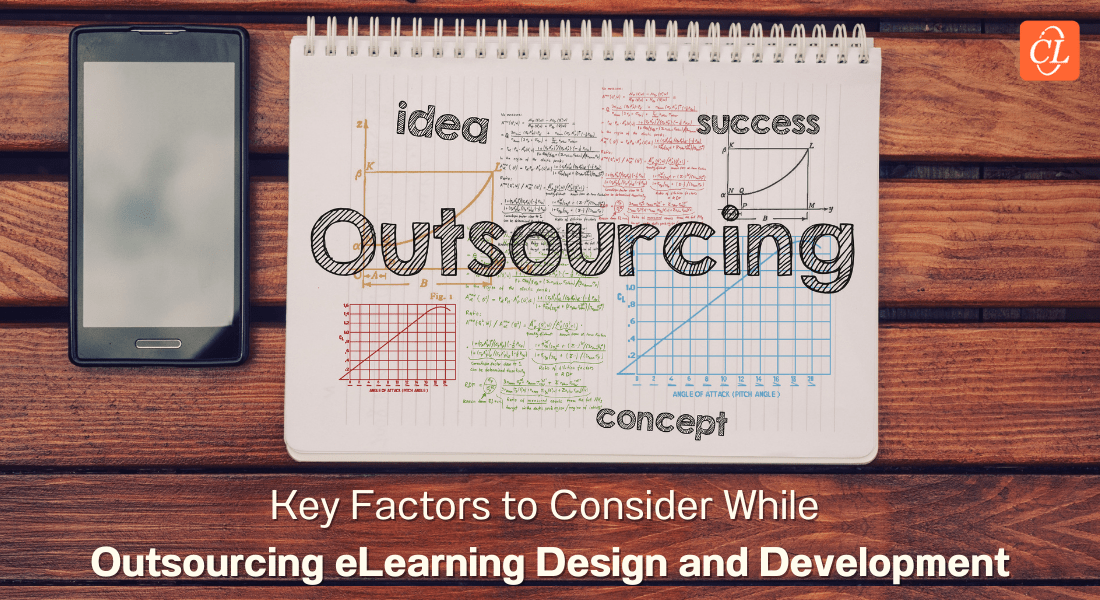What are the 5 Steps in the Outsourcing eLearning Development Process?

As a training manager or somebody responsible for the training initiatives in your organization, you need to have an idea of the eLearning design and development process, when it’s outsourced to an external eLearning vendor. Having clarity on the process that follows eLearning outsourcing will yield optimum results. But don’t worry if you have no idea of what outsourcing eLearning development involves. This blog post will give you a comprehensive idea.
→ Download Now: eLearning Outsourcing — Best Practices to Make the Smart Choice
Table of Contents
- What is eLearning Outsourcing?
- What Are the Benefits of eLearning Outsourcing?
- What are the 5 Steps in the Outsourcing eLearning Development Process?
What is eLearning Outsourcing?
eLearning outsourcing is like hiring a helper to design and develop your eLearning courses. This eLearning outsourcing partner has a team of specialists who are great at designing online learning that's both interesting and effective. Moreover, they stay up-to-date on the latest training ideas, eLearning authoring tools, and instructional design strategies. In short, from writing the content to adding quizzes and videos to make the training engaging, they are capable of handling every task involved in the eLearning design and development process.
What Are the Benefits of eLearning Outsourcing?
From saving time and cost to ensuring learner engagement, outsourcing your eLearning content development can benefit you in multiple ways. Watch this video to know the benefits of outsourcing eLearning development for corporate training in detail.
What are the 5 Steps in the Outsourcing eLearning Development Process?
What Are the 5 Important Steps in the Outsourcing eLearning Development Process?
Here’s a list to help you out:
- Analyzing the Content
- Developing the Storyboard
- Developing a Prototype
- Submitting the Course to the Stakeholders
- Deploying on an LMS
Here’s a detailed look at the 5 steps involved in the eLearning course development process when you outsource it to an eLearning vendor.
1. Analyzing the Content
When you outsource your eLearning content creation, instructional designers at the eLearning partner’s end will analyze the raw content or legacy training material such as PPTs, PDFs, manuals, worksheets, and other pre-designed material you provide as inputs for the course.
This is what they do:
- Collate the course material from the raw content
- Identify gaps, if any, and seek clarification/additional material from your SMEs
- Structure the content in a logical order
- Finalize the instruction design strategy
- Develop the Detailed Content Outline (DCO) with a clear breakup of the course modules, units, and screen titles
- Decide on the screen-level treatment of the content (animations/videos/assessments, etc.)
So, analyzing the given inputs is the first and key step in developing training courses in eLearning outsourcing.

A Practical Guide to Outsourcing eLearning Design & Development
Tips and Best Practices for an Effective Outsourcing Journey
- eLearning Elements that can be Outsourced
- Tasks Before Outsourcing
- Tips for Selecting the Right eLearning Vendor
- Ways to Support Your Vendor
2. Developing the Storyboard
In the second step, instructional designers develop the storyboard. A storyboard is a blueprint and the guiding document for content, visuals, audio, and interactive elements. Storyboarding is a crucial step in the outsourcing of the end-to-end eLearning development process, as the strategy for onscreen content presentation and the audio script are finalized here.
Choosing images, designing animations, and developing eLearning interactivities are some of the tasks involved in the visualization of onscreen content. Formative and summative assessments are also developed in the storyboarding phase. Formative assessments come after each unit, whereas summative assessments come at the end of the course as a final mastery quiz.

3. Developing a Prototype
A prototype is a scaled-down, fully functional representation of the eLearning course being developed. A prototype typically contains 10% of an eLearning course. It contains all the elements to be included in the “actual” course, such as eLearning assessments, Graphical User Interface (GUI), interactivities, videos, and audio.
Developing a prototype helps the organization and the eLearning partner to agree and finalize the content, visuals, audio, and technical functionalities of the course. This helps avoid any confusion or misunderstanding in the upcoming stages or final outcome. The prototype is hosted on a Learning Management System (LMS) to ensure no problems arise when the “full course” is hosted on the LMS. This is also checked for compatibility with various browsers and devices.
Checking the functionalities of the training course, visual presentation, and audio narration is a very important phase in developing an eLearning course, as it goes a long way in avoiding re-work.

A Practical Guide to Outsourcing eLearning Design & Development
Tips and Best Practices for an Effective Outsourcing Journey
- eLearning Elements that can be Outsourced
- Tasks Before Outsourcing
- Tips for Selecting the Right eLearning Vendor
- Ways to Support Your Vendor
4. Submitting the Course to the Stakeholders
The fourth step in the process is ‘Course Submission’. This is done in two stages.
Without Audio – Alpha Version
Here, the eLearning development partner will send the fully functional course for your approval. You can approve the course or provide necessary feedback on various aspects such as the visuals used, animations, treatment of the content, writing style, and audio script. Once you give the final approval on the audio script, it is sent for recording.
With Audio – Gold Version
In this stage, the fully functional course with audio is sent for your approval. This version of the course is commonly known as the Gold version. The course is ready in all respects except being LMS-compliant. The eLearning outsourcing partner will wait for your final approval of the whole course.
5. Deploying on an LMS
Once you approve the course with audio, the eLearning development partner will make the eLearning course compliant with the desired learning technology standards such as SCORM, AICC, or xAPI. Once this task is complete, your eLearning course is ready to be deployed on an LMS and delivered to your learners.

Wrapping It Up!
Knowing the end-to-end eLearning development process will help you make the most of the online course development outsourcing initiative and be prepared to deal with any situation that might arise. Having second thoughts about outsourcing eLearning development? In a dilemma whether to opt for eLearning outsourcing or develop eLearning in-house? Want to know how much it will cost if you outsource your eLearning requirement? Most important of all, how to find the right eLearning outsourcing partner. Find answers to all these questions in our free eBook. Download now!
Editor’s note: This post was originally published on November 30, 2016 and has been updated for comprehensiveness.





![What Can You Outsource in Custom eLearning Development? [Infographic]](https://blog.commlabindia.com/hubfs/Imported_Blog_Media/custom-elearning-outsource-components.jpg)